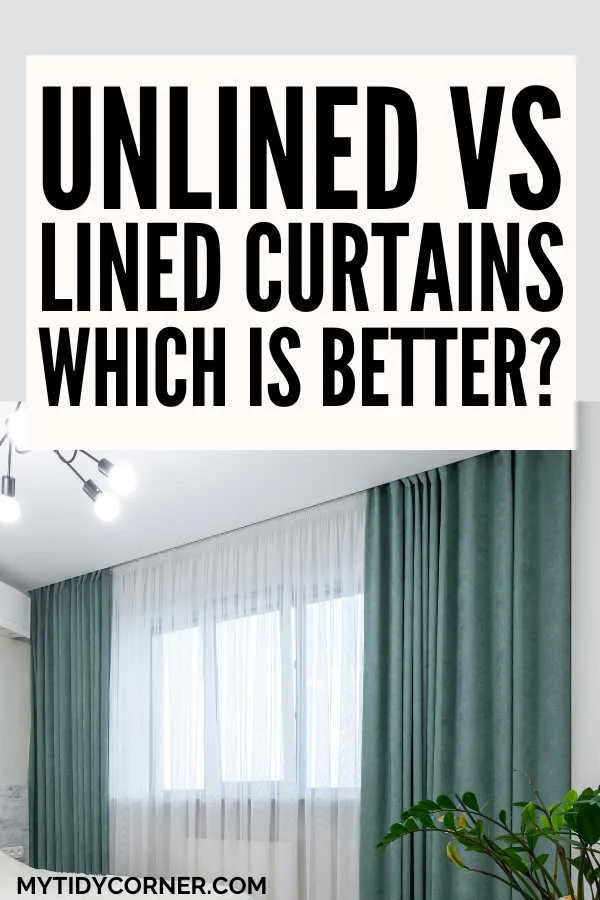Unlined Vs Lined Curtains (Which Option is Right for Your Home?)
If you are like me, you may be wondering, lined vs unlined curtains, which is better? Let’s look at when, where, and why to use lined and unlined curtains.
I get a creative kick out of choosing colors, fabrics, and styles of window treatments. Thinking about lining is less exciting – and I’ve been wondering if it’s even necessary. However, experts in drapery usually recommend lining curtains. What’s the difference between lined and unlined curtains and which is better?
Choose lined curtains to block light and sound, prevent sun damage, for privacy and insulation. Line heavy curtain fabrics to hang better. Unlined curtains work well in sheer and semi-sheer fabrics, combined with blinds, or in rooms where privacy, insulation, and light control are unnecessary.
Whether buying ready-made curtains or having bespoke window treatments made, the question of lining will arise. There are several types of lining to choose from and different aesthetic and practical reasons for lining your curtains.

Related Articles:
- 11 Amazing Window Curtain Alternatives
- How Far Off the Ground Should Curtains Be?
- How to Measure for Curtains
The Difference Between Lined and Unlined Curtains
What are Unlined Curtains?
Curtains are panels or lengths of fabric that you hang from a curtain pole with hooks or rings, usually in front of a window or door.
When the drapery panels consist of only one layer of fabric, they are called unlined curtains, meaning they have no second layer or lining attached to them.
A separate curtain made of net or voile hanging behind another curtain is not a lining, although it does function as one. You have two sets of unlined curtains hanging together.
What is a Lined Curtain?
Lined curtains consist of two layers of fabric:
- A front layer that will face the room and is typically decorative
- A back layer or lining attached to the front layer either across the width or both the width and length or may be detachable. The lining is usually tightly woven, light-colored cotton or polyester, faces the window, and can be seen from outdoors.
If curtains are washable, the lining may be attached. However, a detachable lining is handy if the curtains need dry cleaning or handwashing, as the lining is generally machine washable.
Lined or Unlined Curtains – Which is Better?
If you are faced with choosing between lined and unlined curtains, here are some of the important factors you to consider.
Aesthetics
Lining a curtain improves its aesthetic appeal, meaning it makes the curtain look better. For example:
- Medium to heavyweight fabrics, like satin or velvet, are lined to bulk out the pleats and add fullness to the drapes. This much-needed lining enhances the luxury of the fabric, especially if you use a crease-resistant, polyester satin twill with a soft sheen.
- Lightweight voile or cotton curtains can look thin if not lined, particularly when the sun shines through them. A polycotton lining will give the curtains substance and make them hang neatly.
- A lining prevents those outdoors from seeing the inside of the fabric, including the seams, creating a neater finish.
That being said, unlined curtains showcase the curtain’s fabric. Most unlined curtains are made from sheer, soft fabrics, like muslin or gauze; the sheerness of the fabric is intentional, as it creates a relaxed ambiance and romantic aesthetic.
Privacy
Another important function of curtains is to create privacy, preventing people from seeing into your home. This is particularly important for bedrooms and bathrooms, where it is best to choose lined curtains.
Remember that the sun can shine through thinner fabrics. Lit-up rooms at night can also create privacy problems, so get some lined curtains you can pull closed.
Light Control
Curtains can help block light from a room: the glare of sunlight during the day, brightness on long summer nights, or the flickering of streetlights and cars at night. Curtains with a lining are the best option for light control.
Choose curtains with a blackout lining to ensure complete darkness in a bedroom or movie room. This technical fabric is coated with a treatment that prevents light from passing through it but retains the soft drape of the curtain. Blackout lining isn’t necessarily black – it comes in white and cream as well.
If you want a bright and airy living space, choose unlined curtains since they allow natural light to filter through the fabric.
Insulation
Lined drapes have the added advantage of insulation, as they can trap warmth between the curtain and the lining. This keeps a room warm in winter but cooler in summer.
If insulation is a concern, choose thermal lining for your curtains, especially those in front of doors. Thermal lining is specially designed to help reduce energy bills in your home and is available for curtains and blinds. It has three layers, giving the lining its thermal properties.
Noise Reduction
Lined curtains are an excellent idea if you live in a noisy area. Lining curtains can help reduce noise pollution that may prevent you and your family from sleeping as it insulates the windows.
If noise from neighbors or traffic is a particular problem, choose a sound-proof lining that will reduce sound significantly, even canceling it out.
Durability
Backing your curtains with lining will extend their lifespan, particularly as they block UV light from the curtain fabric, preventing fading and damage.
Lined curtains can also prevent the sun from fading floors, furniture, and other soft furnishings.
Cost
Unlined drapes are more affordable than the lined ones since they do not need extra lining material. The cost of the lining material adds to the cost of lined curtains.
Unlined curtains are also easier to maintain. They are made with lightweight fabrics (no extra layer or lining) that can be machine washed without problems.
Dust Blocking
Living on a busy or dusty road means pollution and dirt seep in, even if you keep windows and doors closed. The lining on curtains catches much of this grime, preventing your curtains and the rest of your home from getting too dirty.
Fire Retardant
While most lining will be a fire hazard, you can purchase curtain lining treated with a fire retardant. Consider lining your curtains with this fabric if you have an open fireplace or kitchen curtains near the stove.
Are Unlined Curtains Okay?
There are many advantages to having your curtains lined, but unlined curtains also have a place. So when should you choose unlined curtain?
Use unlined curtains:
- where you want bright airy atmosphere
- where you don’t need to block out sun or light
- without the need for complete privacy
- that don’t need insulation in terms of temperature or sound
- for living room, dining room, home office or study room
Unlined curtains are often used in combination with blinds. The blinds will play the role of lining, i.e., blocking light and sound, while the curtains add aesthetic value.
You can also combine unlined curtains, hanging a decorative curtain in front and a second curtain (e.g., of net or voile) behind it to reduce glare and increase privacy.
Final Thoughts on Lined Vs Unlined Curtains
Lined curtains are a sensible choice as they are better at blocking light and sound, creating privacy, and insulating a room. They tend to hang better and last longer. Unlined drapes are ideal if you don’t need insulation, light-blocking, or privacy and you delight in the billowing beauty of sheer fabrics.
Did you find our take on lined vs unlined drapes helpful? Leave your comment below.

